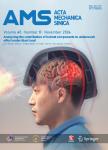Three-dimensional constitutive model for magneto-mechanical deformation of NiMnGa ferromagnetic shape memory alloy single crystals
为 NiMnGa 铁磁性的形状记忆合金单身者晶体的磁电机机械的变丑的三维的组成的模型作者机构:State Key Laboratory of Traction PowerSouthwest Jiaotong UniversityChengdu 610031China Applied Mechanics and Structure Safety Key Laboratory of Sichuan ProvinceSchool of Mechanics and EngineeringSouthwest Jiaotong UniversityChengdu 610031China School of Mechatronics EngineeringUniversity of Electronic Science and Technology of ChinaChengdu 610031China
出 版 物:《Acta Mechanica Sinica》 (力学学报(英文版))
年 卷 期:2019年第35卷第3期
页 面:563-588页
核心收录:
学科分类:08[工学] 0801[工学-力学(可授工学、理学学位)]
基 金:the National Natural Science Foundation of China (Grant 11602203) Young Elite Scientist Sponsorship Program by the China Association for Science and Technology (Grant 2016QNRC001) Fundamental Research Funds for the Central Universities (Grant 2682018CX43)
主 题:Ferromagnetic shape memory alloys Single crystals Magneto-mechanical deformation Martensite transformation Martensite reorientation Constitutive model
摘 要:Existing experimental results have shown that four types of physical mechanisms, namely, martensite transformation, martensite reorientation, magnetic domain wall motion and magnetization vector rotation, can be activated during the magneto-mechanical deformation of NiMnGa ferromagnetic shape memory alloy (FSMA) single crystals. In this work, based on irreversible thermodynamics, a three-dimensional (3D) single crystal constitutive model is constructed by considering the aforementioned four mechanisms simultaneously. Three types of internal variables, i.e., the volume fraction of each martensite variant, the volume fraction of magnetic domain in each variant and the deviation angle between the magnetization vector, and easy axis are introduced to characterize the magneto-mechanical state of the single crystals. The thermodynamic driving force of each mechanism and the thermodynamic constraints on the constitutive model are obtained from Clausius s dissipative inequality and constructed Gibbs free energy. Then, thermodynamically consistent kinetic equations for the four mechanisms are proposed, respectively. Finally, the ability of the proposed model to describe the magneto-mechanical deformation of NiMnGa FSMA single crystals is verified by comparing the predictions with corresponding experimental results. It is shown that the proposed model can quantitatively capture the main experimental phenomena. Further, the proposed model is used to predict the deformations of the single crystals under the non-proportional mechanical loading conditions.



